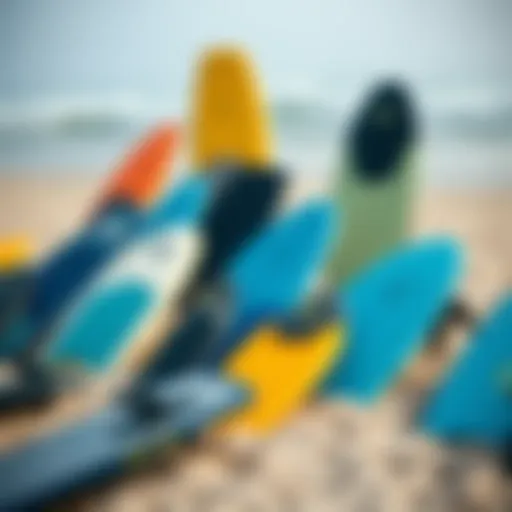Discovering the Wonders of Glass Beach, California

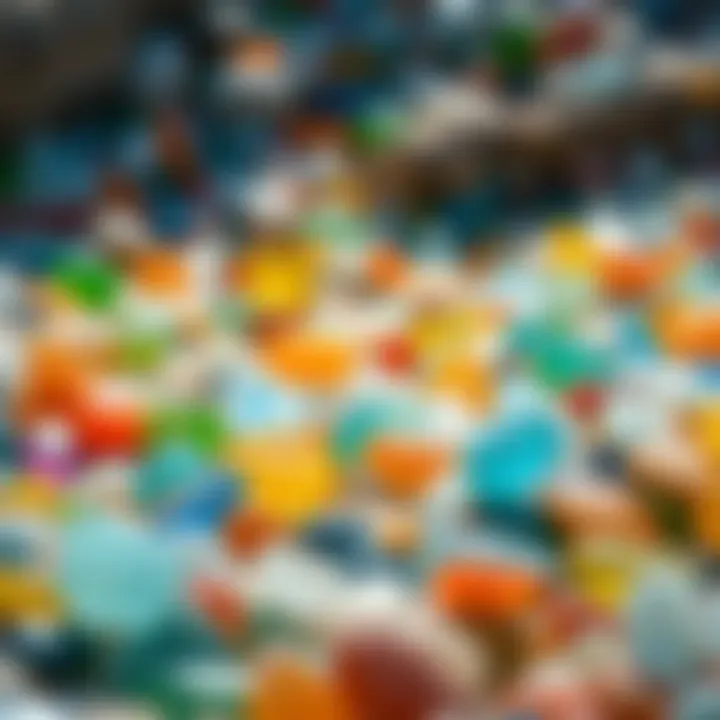
Intro
Nestled along the rugged coast of Northern California, Glass Beach stands as a testament to nature's ability to transform human effect into beauty. Originally a dumping ground for debris, this area has become a breathtaking landscape peppered with smooth, colorful glass pebbles, drawing visitors from all walks of life. It’s more than just a scenic spot; Glass Beach encapsulates tales of history, community, and ecological evolution.
On this journey, we will delve into the fascinating origins of the glass formations, explore their environmental implications, and uncover the cultural significance that surrounds this iconic site. Additionally, practical aspects for visitors—including accessibility and safety tips—will ensure that everyone can enjoy this unique locale while considering the ongoing efforts for ocean conservation. So, whether you’re a seasoned surfer or an eco-enthusiast, there’s something for you at Glass Beach.
Let’s dive into the unique phenomena that make this beach a memorable destination and practical ways to appreciate it fully.
Techniques and Tips
As you stand before the vibrant glass-strewn sands, it's essential to not only soak in the sights but also engage with the coastal waters safely. Here are some techniques and tips for getting the most out of your time at Glass Beach.
Essential Surfing Techniques for Beginners
If you're new to surfing, the waters at Glass Beach can be both inviting and challenging. To ensure a smooth experience:
- Leash Up: Always wear a surfboard leash to keep your board close in case of a wipeout.
- Start Small: Look for smaller waves especially suited for beginners to build your confidence before tackling larger swells.
- Position Yourself Right: Paddle out diagonally to avoid the breaking waves directly, which can be demanding for beginners.
- Learn to Fall: Knowing how to dive under or fall off your board safely minimizes injury and makes paddling back in easier.
Advanced Maneuvers for Experienced Surfers
For those with a bit more salt in their hair, Glass Beach offers conditions that can challenge even the best surfers. To push your limits:
- Carving Turns: Work on executing smooth, styled turns when catching waves; it adds flair to your ride.
- Duck Diving: Mastering this technique to get under waves effectively can save you energy and keep your momentum.
- 360 Degree Turns: Experiment with complete rotations to improve your control and agility on the board.
- Tubes and Barrel Riding: Timing is everything; practice positioning yourself correctly to ride through the waves.
By honing these skills, you can deeply connect with the ocean, fostering a relationship that's respectful of both the environment and the surf culture surrounding Glass Beach.
Remember, respect the ocean, heed its cues, and enjoy the beauty that this unique coastal experience provides. If you wish to learn more about surf techniques and safety, resources such as Surfline or TheSurfingHandbook can offer valuable insights.
Foreword to Glass Beach
Glass Beach, located in Fort Bragg, California, is much more than a coastal destination; it's a symbol of resilience and transformation. Over the years, this unique beach has garnered attention due to its striking glass-strewn shoreline, which offers an aesthetic spectacle unlike any other. Understanding the narrative behind Glass Beach requires a look at its historical, geographical, and ecological context. This introduction sets the stage for a deeper exploration of the myriad elements that contribute to the beach’s allure, as well as the considerations that come with visiting this remarkable site.
Historical Background
The tale of Glass Beach is intricately tied to the history of human activity in the region. What is now a sparkling treasure trove of smooth glass fragments was once a dumping ground for trash and debris. From the early 20th century until the 1960s, this area was used as a dump, where not only household waste but also industrial refuse ended up on the shores. Over time, nature took its course; the relentless action of waves and tides eroded the glass, leading to the creation of the beautiful pebbles that color the beach today. The transformation from a neglected wasteland to a coveted attraction is a glowing testament to nature’s ability to reclaim and beautify—a metaphor for renewal and responsible stewardship of the environment.
This history serves as a reminder of the consequences of human waste. It is an important factor that every visitor should bear in mind when visiting the beach. Understanding the past enriches the experience and encourages a culture of conservation among those who tread on this enchanting sand.
Geographical Significance
Glass Beach is not just breathtaking to behold; it also holds significant geographical importance. Nestled along the rugged coastline of Northern California, it is positioned in a location where the Pacific Ocean meets rocky cliffs adorned with native vegetation. The sandy shore is frequently washed by powerful surf, which influences the erosion process that shapes the glass fragments.
The unique geology of the area contributes to the beach’s distinct landscape. The diverse marine ecosystem, characterized by tide pools and rocky outcrops, provides a habitat for various marine species. From starfish to sea urchins, the beach supports a vibrant life below the surface, further enhancing its ecological value.
"Glass Beach is a remarkable example of how human action can lead to unexpected beauty and ecological restoration."
Moreover, the location allows easy access for surfers and beachgoers alike, making it a popular spot for various outdoor activities. Its proximity to amenities in Fort Bragg, such as restaurants and lodging, enhances the overall experience for visitors. For anyone keen on surf culture, nature, or simply off-the-beaten-path exploration, Glass Beach stands as a striking amalgamation of history, beauty, and adventure in the great outdoors.
The Formation of Glass Beach
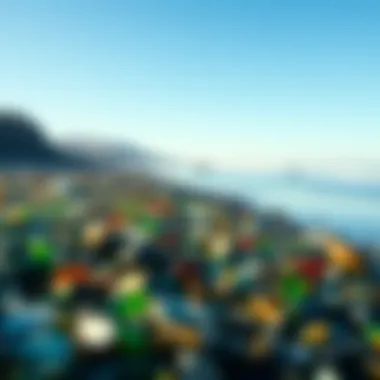
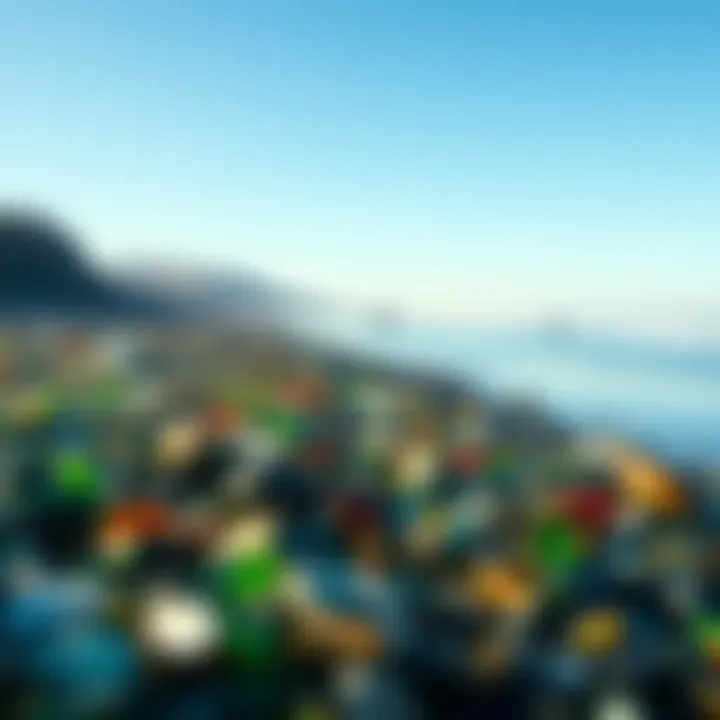
The formation of Glass Beach stands as a testament to the intersection of natural forces and human activity. Understanding how this unique area came to be enriches our appreciation not only for its beauty but also for the lessons it imparts regarding environmental stewardship. The colorful fragments of glass that wash up on its shores are not merely a random spectacle; they're a result of several pivotal processes, both organic and anthropogenic. By digging deep into these origins, visitors can grasp how such a remarkable beach emerged and the implications it has for conservation efforts.
Natural Processes
The creation of Glass Beach can largely be attributed to natural geological processes acting over decades. The intricate dance between waves, wind, and land plays a crucial role in shaping coastlines and creating unique features. In this case, the constant erosion of cliffs and rocks along the shoreline contributes significantly to the beach's character.
- Erosion: Waves relentlessly pound the shoreline, breaking down larger pieces of rock and debris into finer particles. This idea of erosion isn’t new, but in the case of Glass Beach, nature gets a bit of help from its surroundings.
- Weathering: The elements, such as rain and wind, further deteriorate materials, shaping and polishing them over time. This natural weathering process is crucial. It creates smooth, rounded pieces from jagged shards of glass and other materials that wash ashore.
- Transport: Ocean currents and tides assist in transporting these materials, allowing for a diverse assortment of textures and colors to accumulate in one place. The interplay of various factors leads to vibrant displays that entice visitors and keeps surf culture alive.
In some ways, Glass Beach reminds one of a master artist's palette; each wave blends pigments representing time, energy, and earth. Observing these processes highlights how nature tirelessly shapes its own masterpiece, reminding us of the transient beauty of natural art.
Human Impact
Human behavior has also dramatically influenced the formation of Glass Beach. Initially, the cavity of this place bore witness to a landfill, where discarded bottles, glass, and other refuse were tossed aside carelessly for years. This practice, while harmful, inadvertently set the stage for the unique transformation of the beach.
- Landfill Practices: From the 1940s to the late 1960s, waste disposal was a common sight here. The lack of environmental awareness led to quick dumping practices that left a mark on the landscape. This initial phase defines a stark contrast between unspoiled nature and human negligence.
- Turning to Treasure: Over time, ocean waves chipped away at this discarded glass, washing and smoothing it into the beautiful pebbles we see today. It's fascinating to think that something thrown away without thought could end up being a sought-after highlight of the region.
- Awareness and change: Today, the significance of not only the beauty but also the cautionary tale behind the glass pieces has led to increased awareness about waste disposal and environmental conservation. The remnants serve as a reminder of the need for mindful behavior towards our ecosystem.
Thus, the collapse of old practices gave rise to new understandings. While the human impact was initially destructive, it paradoxically allowed for the creation of a cherished natural wonder. Visitors can enjoy the beauty of Glass Beach, but it carries a narrative that transcends aesthetics — a call for mindfulness as we interact with nature.
"In the end, we do not inherit the earth from our ancestors, we borrow it from our children." – Native American Proverb
The complexities behind Glass Beach exemplify how both natural and human forces can shape a place over time. Understanding these dynamics deepens our connection to the beach and encourages us to become more engaged in preserving such environments.
Ecological Aspects of Glass Beach
The ecological aspects of Glass Beach are pivotal for understanding not just its allure but also the broader environmental narrative that shapes this unique location. These elements intertwine, creating a vibrant ecosystem that supports both wildlife and the coastal environment. Visitors may be attracted to the colorful glass pieces, but the real story is about the intricate balance that exists within this coastal habitat. In this section, we will explore how local wildlife interacts with this unique landscape and consider the environmental concerns that arise in the context of human visitation and conservation efforts.
Impact on Local Wildlife
Glass Beach serves as a habitat for a myriad of marine and terrestrial species, creating a fascinating juxtaposition between natural life and human activity. The richness of the beach encourages a variety of organisms to thrive. Notably, you will find bird species such as the Western Snowy Plover, which uses the sandy areas for nesting. The glass pieces, though they may seem inhospitable, can provide shelter for small crabs and other marine life.
Often, beachcombers might notice how numerous species adapt to these artificial structures formed from glass. Seabirds, for example, can use the elevated glass areas as vantage points while hunting for food. This relationship between the glass and wildlife illustrates a dynamic where natural selection is interwoven with human impact. Additionally, the vibrant tide pools offer a sampling ground for a range of invertebrates and algae, which are integral to the local food web.
In essence, while the glass may have originated from human waste, a peculiar relationship has formed, nurturing local wildlife in a way that reflects adaptation and survival in a changing environment.
Environmental Concerns
As much as Glass Beach is a marvel, it does not come without its set of environmental concerns. One pressing issue is the impact of tourism, which, while beneficial to local economies, can strain the delicate ecosystems present. The increased foot traffic often leads to habitat destruction. Poorly managed paths can result in erosion and degradation of native vegetation, which is vital for maintaining soil integrity and providing shelter for wildlife.
Moreover, there are ongoing debates regarding the quality of the glass itself. While the colorful shards have drawn many, concerns exist about whether some pieces can cause harm to both people and animals. A jagged edge from an unprocessed shard could be a hazard for visitors. Furthermore, the slow dissolution of glass in the marine environment raises questions about leaching harmful chemicals and altering water quality.
It’s crucial for visitors and conservationists alike to consider these factors when discussing the allure of Glass Beach. Raising awareness about maintaining this coastal treasure ensures that future generations can also experience its beauty while preserving the ecological integrity of the region. To protect these ecosystems, responsible tourism practices must be embraced, ranging from the simple act of staying on designated paths to participating in local clean-up efforts.
"The balance between human enjoyment and environmental preservation is a delicate dance that must be respected."
By understanding the ecological aspects and considering the environmental impact of human activities, we can cultivate a deeper appreciation for what makes Glass Beach a unique coastal experience while ensuring its beauty and biodiversity endure.
Visitation Guidelines for Glass Beach
Visitation guidelines for Glass Beach hold remarkable significance, ensuring that visitors enjoy this enchanting site while preserving its delicate environment. As a unique coastal destination, it attracts diverse individuals, from surfers to conservationists. Understanding how to navigate this space responsibly enhances the overall experience for everyone.
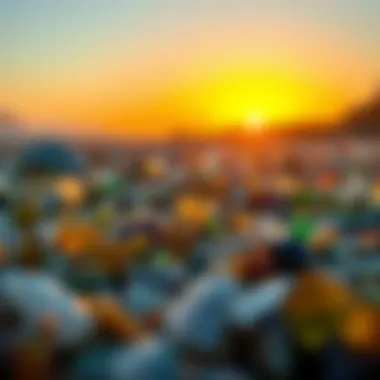

Accessibility
Accessibility at Glass Beach can be a bit tricky depending on the route you choose. The beach is mainly located in Fort Bragg, California, accessible via a short drive from nearby towns. For those traveling from farther away, US-101 is your best bet to reach this mesmerizing locale.
Once there, visitors will find convenient parking options, although spots can fill up quickly during peak times. It’s essential to arrive early, especially during weekends or holidays, to secure a good place.
The paths leading down to the beach can be uneven and steep. Not everyone may find it easy to navigate, particularly those with mobility issues. However, the breathtaking views that await those who make the trek down are well worth the effort.
Moreover, if you’re bringing along kids or elderly family members, it's wise to inquire about nearby amenities. Restrooms and other facilities can greatly enhance comfort during your visit. Keep in mind that services can be limited, so planning accordingly is always a good idea.
Safety Precautions
While Glass Beach is a treat for the eyes, visitors should take certain safety precautions to fully enjoy their time without mishaps. With glass pieces baked in the sand, one could unwittingly find themselves in a sticky situation. Here are some tips to make sure your visit remains enjoyable.
- Footwear: Wearing sturdy shoes designed for walking on rocky surfaces is a must. Flip-flops might not be the best choice here.
- Beach Conditions: The ocean can be unpredictable. Pay attention to tide charts and observe ocean currents; a sudden wave could surprise unprepared beachgoers.
- Wildlife Awareness: Keep an eye out for wildlife in and around the beach. As this area is home to various species, respectful observation from a distance is advisable. Disturbing habitats can jeopardize the local ecosystem.
"Being mindful of the environment and fellow visitors not only brings personal satisfaction but also helps maintain the charm of Glass Beach for years to come."
In sum, having a solid understanding of the accessibility and safety precautions ensures that your visit to Glass Beach is both memorable and responsible. As you prepare for your adventure, remember that enjoying this natural wonder goes hand in hand with protecting it.
The Cultural Significance of Glass Beach
Understanding the cultural significance of Glass Beach goes beyond just viewing its striking glassy shore. This location resonates deeply with local history, community narratives, and artistic expression. For surfers and travelers alike, the beach offers not just a spot to catch waves, but also a chance to connect with the area’s storied past and ongoing cultural evolution. The glass itself, a product of time and tides, serves as a powerful metaphor for transformation, capturing both the beauty of nature and the marks of human history. The aesthetic and historical elements intertwine, making Glass Beach a symbol of resilience and creativity.
Local Legends and Myths
Glass Beach is steeped in local legends, each adding a layer of mystique to the shoreline. One prevalent story speaks of a treasure trove of glass shards that washed ashore as remnants of old bottles from shipwrecks, a tale that blends fact with folklore. It’s said that these shards are lucky, embodying the spirits of sailors lost to the sea, turning the beach into a sacred ground of sorts. Locals often share anecdotes about how finding a particularly unique piece of glass can be the start of a good fortune or a new adventure.
- Folklore and Community Identity: These legends contribute to a shared community identity. Residents take pride in the stories passed down through generations, fostering a stronger connection with one another.
- Camaraderie among Visitors: Tourists and locals alike are often seen exchanging tales or looking for glass together, creating a unique camaraderie that enriches their experiences.
Art and Expression
The artistic vibe at Glass Beach is undeniable. The vibrant glass pieces tell the story of human creativity molded by nature. Artists frequently visit to find inspiration or create pieces that reflect the beach's unique charm. Some locals incorporate glass fragments into jewelry, sculptures, and mosaics, giving new life to materials that might otherwise be discarded.
"Artistic endeavors not only preserve the memories of Glass Beach but also depict modern interpretations of its beauty, showcasing the creative spark that this locale ignites."
- Installation Art: Various spontaneous installations by artists also pop up, temporarily enhancing the beach's experience. Visitors find joy not just in collecting glass, but also in witnessing how others interpret their surroundings through innovative expressions.
- Environmental Art Projects: Groups often engage in beach clean-up efforts that are then celebrated through artistic installations, blending conservation with creativity. These projects highlight the importance of preserving such a unique environment while simultaneously fostering artistic expression.
In summary, Glass Beach is more than a geological wonder; it stands as a canvas for stories, legends, and artistry. For surfers and visitors, it is a reminder that each piece of glass carries with it tales of the past and the potential for future creativity. Exploring this beach sinks one into a deeper understanding of the ties between nature, history, and cultural expression.
Glass Beach and Surf Culture
Glass Beach, located in the coastal town of Fort Bragg, California, brings together the love for surfing with an enchanting backdrop. Surfers from around the world flock to this location not just for the unique glass-strewn shores but also for the impressive waves that grace the area. The connection between the surf culture and Glass Beach is significant, providing both a recreational outlet and a canvas for artistic expressions related to the ocean.
Surfing Conditions
The surfing conditions at Glass Beach can vary significantly depending on the season and weather patterns. Typically, the best waves can be found in the fall and winter months, when swells generated by Pacific storms provide ideal surfing opportunities. Here’s a summary of the conditions you can expect:
- Wave Height: Ranges from three to eight feet on average during peak months.
- Water Temperature: Generally chilly, averaging between 50°F to 60°F. A good wetsuit is essential for comfort and warmth.
- Best Weather: Overcast days can offer cleaner waves since storms clear away debris, enhancing the surfing experience.
- Skill Levels: While there are spots suitable for beginners, the more challenging breaks cater to experienced surfers seeking thrills.
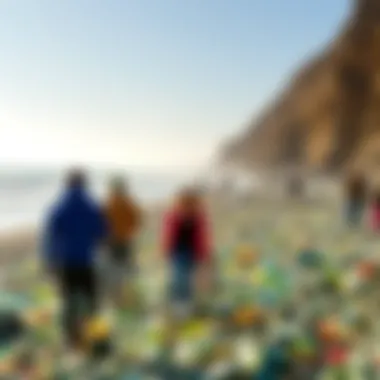

Importantly, the rocky shoreline surrounding Glass Beach presents both unique opportunities and risks. Knowing the tide charts is crucial, as high tides can change surf conditions rapidly. Surfers should also be aware of the potential for rip currents, which may pose risks, especially to less experienced wave-riders.
Experience and Techniques
Surfing at Glass Beach is more than just hitting the waves; it's about embracing the vibe that this unique location offers. Riders often describe a deep connection with nature while riding the glassy waves. Here are some considerations and techniques that can enhance your experience:
- Wave Reading: Understanding the swell direction and how it interacts with the rocky outcrops is key to making the most of your time. This requires practice and an eye for how the water behaves.
- Paddle Technique: Given the sometimes rough conditions, effective paddling can make a world of difference. Focus on broad, powerful strokes to quickly get you into position.
- Board Selection: Longer boards may provide easier paddling for beginners, while shorter boards offer greater maneuverability for the more experienced crowd, particularly when navigating through glass scattered along the shore.
- Respect the Local Culture: Connecting with fellow surfers and local instructors can enhance your surf experience. They can offer valuable insights and tips tailored to the unique characteristics of Glass Beach.
Surfing at Glass Beach isn't merely about catching waves. It's about immersing yourself in a vibrant culture that honors the environment and the ocean.
In summary, Glass Beach is a sanctuary for surfers looking for both challenges and beauty. While enjoying your time on the waves, maintaining awareness of the local conditions and community will enrich your adventure.
For those looking to dive even further into the surf culture at Glass Beach, consider checking valuable resources like Wikipedia and local surfing forums on Reddit. These platforms can help you connect with other enthusiasts and learn more about the surfing experience in this unique setting.
Conservation Efforts
When one stands on the shimmering sands of Glass Beach, it is easy to get lost in the beauty of the colorful glass pieces scattered across the shore. However, this aesthetic allure carries with it a significant responsibility. Conservation efforts surrounding Glass Beach are not just beneficial; they are essential for the beach's ongoing vibrancy and the natural ecosystem that supports it. By understanding and endorsing these efforts, visitors can partake in preserving this unique environment for future generations.
Protecting Natural Resources
The delicate balance of the coastal ecosystem at Glass Beach is often threatened by human activity. Protecting natural resources here involves several strategies aimed at minimizing harm while promoting healthy regrowth.
- Regular Clean-ups: Local organizations often organize beach clean-ups to remove litter and debris. Participants, including visitors and residents, help keep the beach pristine and hospitable for wildlife. Recent clean-ups saw over 200 volunteers gather to remove trash, contributing to the environment.
- Monitoring Wildlife: Conservationists continually study the local wildlife, ensuring that the unique species that call Glass Beach home, like the tidepools’ starfish, shrimp, and anemones, are flourishing. Awareness of seasonal breeding cycles is integral to avoid disturbing these delicate habitats.
- Restricting Access: During certain times, portions of the beach may be cordoned off to protect sensitive areas. This approach allows marine life to thrive without disruption. It may seem inconvenient, but maintaining these boundaries ensures the overall health of the marine environment.
Community Involvement
Conservation efforts at Glass Beach are deeply rooted in community involvement. When locals take charge, the impact is undeniable.
- Educational Programs: Various educational initiatives target schools and community groups, focusing on understanding the significance of Glass Beach. Workshops on coastal ecology and the importance of preserving natural beauty are not just informative; they create stewards for the environment.
- Local Advocacy Groups: Groups like the Mendocino Coast Audubon Society and the Friends of Glass Beach play pivotal roles. They actively engage the community through events and campaigns that highlight the need for conservation. Here, locals gather to formulate strategies that are both effective and sustainable.
- Partnership with Tourism: As visitors flock to experience this iconic site, businesses in the area partner with conservation initiatives. They promote eco-friendly practices, such as using biodegradable products and educating tourists on responsible beach behavior. This synergy between tourism and conservation fosters a community that values and protects its natural resources.
"A thriving beach is not just a sight to behold but a treasure to preserve for all."
In essence, the conservation efforts at Glass Beach reflect a blend of proactive measures and community dedication, emphasizing the need for each visitor to recognize their role in preserving this unique coastal wonder.
As travelers share memories of Glass Beach, they also gain a deeper understanding of the importance of safeguarding its beauty and ecological balance for those who will come after.
Travel Tips for Glass Beach
When visiting Glass Beach, having the right information can make the difference between a good trip and a great one. This section provides valuable insights into the essentials of making the most out of your journey. Understanding the best times to visit and unique attractions nearby helps create a well-rounded experience, whether you’re there to take in the scenery, surf, or learn about the environment.
Best Times to Visit
Timing your visit to Glass Beach can significantly enhance your experience. Ideal conditions typically occur during late spring through early fall when the weather is warm and sunny. The months of May through September offer pleasant temperatures, with averages ranging from the mid-sixties to low seventies in Fahrenheit. The coastline is often less foggy during these months, providing clearer views of the sparkling glass pebbles on the beach.
Moreover, weekends can attract larger crowds, as both locals and tourists flock to enjoy the beach. If you desire a quieter experience, consider visiting on weekdays early in the morning when most folks are still winding down from their workweek.
For surf enthusiasts, check the local surf reports. Late summer often brings consistent swells, making it a favorite for surfers. However, keep an eye on weather patterns, as conditions can change rapidly along the coast.
Unique Attractions Nearby
Beyond the shimmering glass that adorns the beach, the surrounding area presents various attractions that can draw in any traveler:
- Fort Bragg has its own charm, offering mouth-watering seafood restaurants and quirky shops. The coastal town captures the essence of Northern California.
- Mendocino Headlands State Park, just a stone's throw away, features stunning coastal trails that provide breathtaking views of both cliffs and ocean. The hiking experience allows for glimpses of local flora and fauna, perfect for nature lovers.
- Point Cabrillo Light Station offers a peek into maritime history with its historic lighthouse. Climbing to the top rewards visitors with panoramic ocean views.
- A short drive leads to the charming village of Mendocino, where Victorian architecture meets picturesque coastal landscapes—perfect for a leisurely stroll and a coffee break.
Stay hydrated and pack sunblock; the coastal sun can be quite relentless!



